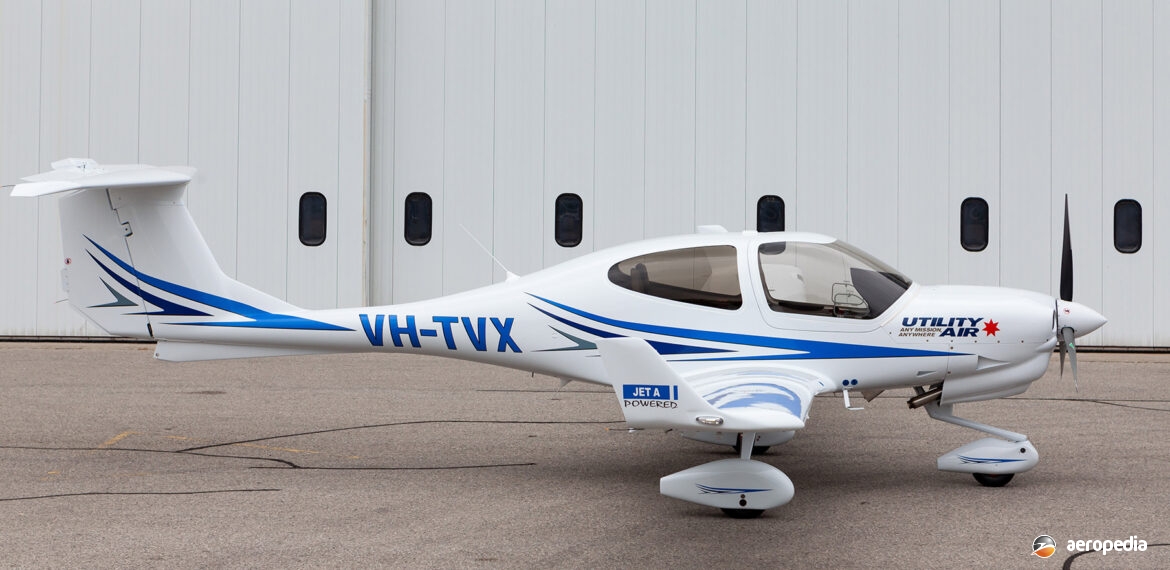Photograph:
Diamond DA-40NG VH-TVX in Canada before delivery in May 2020 (Utility Air)
Country of origin:
Austria
Description:
Four-seat training and touring monoplane
Power Plant:
One 127 kw (170 hp) Austro Engine AE300 turbocharged common-rail injected 2000 cc diesel engine with EECU single-lever control system
Specifications:
- Wingspan: 11.63 m (38 ft 2 in)
- Length: 8.06 m (26 ft 5 in)
- Height: 1.97 m (6 ft 6 in)
- Wing area: 13.54 m² (145.7 sq ft)
- Max cruising speed at 4,267 m (14,000 ft): 287 km/h (178 mph)
- Cruising speed at 70% power at 4,267 m (14,000 ft): 248 km/h (154 mph)
- Cruising speed at 60% power at 4,267 m (14,000 ft): 226 km/h (140 mph)
- Range at 60% power wityh standard tank at 4,267 m (14,000 ft): 1,482 km (921 miles)
- Range at 60% power with long-range tank: 2,093 km (1,301 miles)
- Take-off distance over 15 m (50 ft) obstacle at sea level: 590 m (1,936 ft)
- Landing distance over 15 m (50 ft) obstacle: 632 m (2,073 ft)
- Take-off roll: 290 m (1,280 ft)
- Landing roll at sea level: 303 m (994 ft)
- Rate of climb at sea level: 210 m/min (690 ft/min)
- Empty weight: 880 kg (1,895 lb)
- Useful load: 400 kg (750 lb)
- Loaded weight: 1,280 kg (2,822 lb)
History:
As noted in the Diamond DA-40 article, the DA-40 series has continued to be developed by the manufacturer and has become very popular around the world in the training role.
The DA-40 was a four-seat low-wing cantilever monoplane built from composite materials and had a tricycle undercarriage. The original prototype OE-VPC was powered by a Rotax 914 turbocharged engine and flew for the first time on 5 November 1997, the second prototype OE-VPE foloowing, being fitted with a Continental IO-240 engine. Later the third prototype flew, fitted with the Lycoming IO-360 engine, and this particular model became very popular with training organisations. In 2002 production of the latter model was transferred solely to the Company’s facility at London in Ontario, Canada.
Further models included the XL and FP, the latter having a fixed-pitch propeller and the Lycoming engine, the XL having a constant-speed propeller. The DA-40F had a fixed-pitch propeller and had a carburettor rather than fuel injection.
On 28 November 2002 a new variant known as the DA-40TDI appeared with the 101 kw (135 hp) Thielert Centurion diesel engine but production of this model was discontinued when that engine was cancelled. A joint venture was set up with Shandong Bin Ao Aircraft Industries in China for production of the DA-40TDI. A variant known as the T-52A was a military model, of which 20 examples were obtained by the 557th Flying Training Squadron in the US in 2009. Two other variants were the DA-40XLT in 2013 with an upgraded interior for private touring; and the DA-40 Tundra Star with strengthened undercarriage and tundra tyres for operation from unimproved surfaces.
The DA-40NG was certified in Europe in April 2010 and was fitted with the Austro Engine AE-300 diesel engine operating on JET A-1 fuel. Examples of this model have been imported to this part of the world, the first three being imported to Australia for the Australian International Aviation College Pty Ltd at Port Macquarie, NSW, these becoming VH-YPJ (c/n 40.N290), VH-YPH (c/n 40.N289) and VH-YPF (c/n 40.N288), followed by VH-HPT (c/n 40.N295) registered to its owner in South Australia in December 2012.
The RAAF Air Cadets in early 2019 received its first aircraft VH-UEZ (c/n 40.N390), this aircraft being delivered from the Austrian manufacturer’s facility at Linz in Austria by RAAF Lockheed Martin C-17 Globemaster III, the machine being assembled at the Australian International Air Show at Avalon, VIC where it was placed on display.
The RAAF has replaced all powered and unpowered gliders used by the Cadets with eight new DA-40NG aircraft leased from Perth-based Airflite, the aircraft being supplied by the RAAF but being registered to Air Flight Pty Ltd. The new training aircraft operate from Point Cook, VIC, Richmond, NSW and Amberley, QLD. These aircraft have been fitted with a 127 kw (170 hp) Austro Engines AE-300 diesel unit using JET A-1 fuel. The other seven aircraft were: VH-UEX (c/n 40.N389), VH-UEJ (c/n 40.NC042), VH-UEL (c/n 40.NC043), VH-UEM (c/n 40.NC046), VH-UEO (c/n 40.NC047), VH-UEP (c/n 40.NC048) and VH-UEW (c/n 40.NC049).

